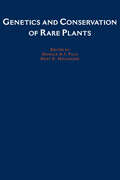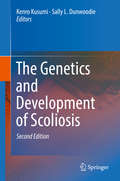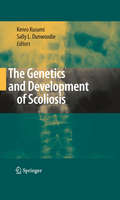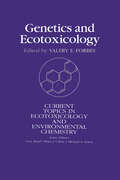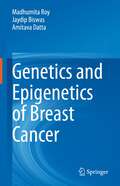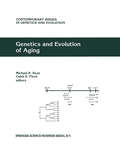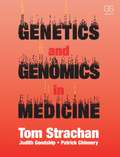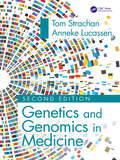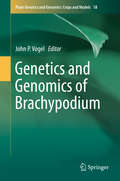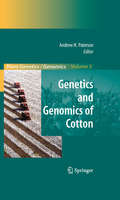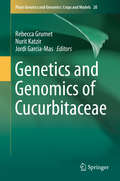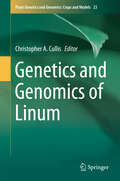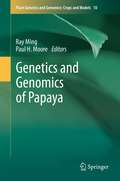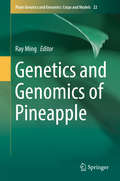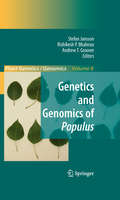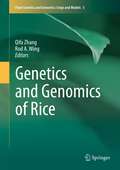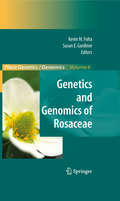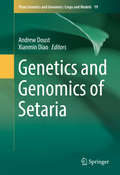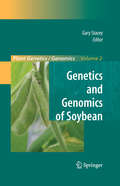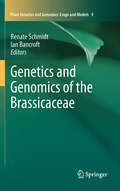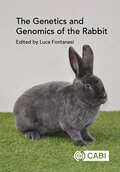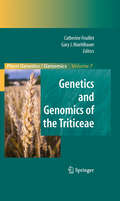- Table View
- List View
Genetics and Conservation of Rare Plants
by Donald A. Falk Kent E. HolsingerNearly 700 species of plants may become extinct by the year 2000. Faced with this overwhelming prospect, plant conservationists must take advantage of every technique available. This unique work summarizes our current knowledge of the genetics and population biology of rare plants, and integrates it with practical conservation recommendations. It features discussions on the distribution and significance of genetic variation, management and evaluation of rare plant germplasm, and conservation strategies for genetic diversity. Case studies focusing on specific problems offer important insights for today's challenges in rare plant conservation.
The Genetics and Development of Scoliosis
by Kenro Kusumi Sally L. DunwoodieOur understanding of the genetic and developmental mechanisms underlying scoliosis is rapidly evolving, this timely second edition of The Genetics and Development of Scoliosis is to provide researchers, clinicians, and students with the most current views in this field. This volume brings together leaders in understanding congenital and idiopathic scoliosis to present the current state of research, and to compare the genetic etiology of these conditions, in order to identify potential shared developmental mechanisms. This book will summarize the recent advances in studies of spinal development and how disruptions during embryogenesis in embryonic segmentation can lead to congenital vertebral defects. In addition, recent reports of genetic loci predisposing patients to develop juvenile and adolescent idiopathic scoliosis will be presented, and key clinical features are reviewed. Finally, there will be discussion of how genetic heterogeneity and gene-environment interactions may contribute to congenital scoliosis and isolated vertebral malformations.
The Genetics and Development of Scoliosis
by Kenro Kusumi Sally L. DunwoodieDevelopmental genetic studies of the spine and linkage and family-based association studies have led to recent advances in understanding the genetic etiology of idiopathic, neuromuscular, and congenital forms of scoliosis. The book is written by leaders in genetic and developmental research on scoliosis and developmental studies of the spine.
Genetics And Ecotoxicology
by Valery E. ForbesThis first volume in the series provides a detailed treatment in ecotoxicology and stresses why genetics is important in understanding if and how chemical contaminants affect populations. Written by an array of international contributors from various fields covering mammals, invertebrates, fish, plants, as well as molecular ecotoxicology, this book considers both ecological/evolutionary consequences and practical implications of the interplay between chemical toxicants and the genetic population.In broadening the understanding of ecological response, this resource ranges from molecular to classical genetics, from plant to animal, from asexual to sexual, touching on some fundamental issues of evolutionary biology. In addition, gaps in our present understanding of genetic and ecotoxicological processes and future research directions have been identified.
Genetics And Ecotoxicology
by Valery E. ForbesThis first volume in the series provides a detailed treatment in ecotoxicology and stresses why genetics is important in understanding if and how chemical contaminants affect populations. Written by an array of international contributors from various fields covering mammals, invertebrates, fish, plants, as well as molecular ecotoxicology, this book considers both ecological/evolutionary consequences and practical implications of the interplay between chemical toxicants and the genetic population.In broadening the understanding of ecological response, this resource ranges from molecular to classical genetics, from plant to animal, from asexual to sexual, touching on some fundamental issues of evolutionary biology. In addition, gaps in our present understanding of genetic and ecotoxicological processes and future research directions have been identified.
Genetics and Epigenetics of Breast Cancer
by Madhumita Roy Jaydip Biswas Amitava DattaThis book discusses the contribution of genetics and epigenetics alterations in the initiation, development, and recurrence of breast cancer. It also reviews the potential of translating the epigenetic alterations into diagnosis, prognosis, and breast cancer therapy. The initial chapters explore the epigenetics, etiology, and conventional treatment strategies for breast cancer. The subsequent chapters discuss the genetic landscape and cover three main epigenetic modulation mechanisms; histone modification, DNA methylation, and miRNA silencing. Further, the book explores the potential of epigenetic drugs in treating breast cancer. Lastly, it covers the phytochemicals targeting epigenetic modulators in breast cancer treatment. This book is an essential source for researchers and practitioners interested in exploring the potential of epigenetics modulators in breast cancer treatment.
Genetics and Evolution of Aging (Contemporary Issues in Genetics and Evolution #3)
by Michael R. Rose Caleb E. FinchAging is one of those subjects that many biologists feel is largely unknown. Therefore, they often feel comfortable offering extremely facile generalizations that are either unsupported or directly refuted in the experimental literature. Despite this unfortunate precedent, aging is a very broad phenomenon that calls out for integration beyond the mere collecting together of results from disparate laboratory organisms. With this in mind, Part One offers several different synthetic perspectives. The editors, Rose and Finch, provide a verbal synthesis of the field that deliberately attempts to look at aging from both sides, the evolutionary and the molecular. The articles by Charlesworth and Clark both provide population genetic perspectives on aging, the former more mathematical, the latter more experimental. Bell takes a completely different approach, arguing that aging may not be the result of evolutionary forces. Bell's model instead proposes that aging could arise from the progressive deterioration of chronic host pathogen interactions. This is the first detailed publication of this model. It marks something of a return to the type of aging theories that predominated in the 1950's and 1960's, theories like the somatic mutation and error catastrophe theories. We hope that the reader will be interested by the contrast in views between the articles based on evolutionary theory and that of Bell. MR. Rose and C. E. Finch (eds. ), Genetics and Evolution of Aging, 5-12, 1994. © 1994 Kluwer Academic Publishers. The J aniform genetics of aging 2 Michael R. Rosel & Caleb E.
Genetics and Genomics in Medicine
by Tom StrachanGenetics and Genomics in Medicine is a new textbook written for undergraduate students, graduate students, and medical researchers that explains the science behind the uses of genetics and genomics in medicine today. Rather than focusing narrowly on rare inherited and chromosomal disorders, it is a comprehensive and integrated account of how geneti
Genetics and Genomics in Medicine
by Tom Strachan Anneke LucassenThe second edition of this textbook written for undergraduate students, graduate students and medical researchers, Genetics and Genomics in Medicine explains the science behind the uses of genetics and genomics in medicine today, and how it is being applied.Maintaining the features that made the first edition so popular, this second edition has been thoroughly updated in line with the latest developments in the field. DNA technologies are explained, with emphasis on the modern techniques that are revolutionizing the use of genetic information in medicine and indicating the role of genetics in common diseases. Epigenetics and non-coding RNA are covered in-depth as are genetic approaches to treatment and prevention, including pharmacogenomics, genetic testing, and personalized medicine. A dedicated chapter charts the latest insights into the molecular basis of cancers, cancer genomics and novel approaches to cancer detection. Coverage of genetic testing at the level of genes, chromosomes and genomes has been significantly expanded and updated. Extra prominence has been given to additional genomic analyses, ethical aspects, and novel therapeutic approaches. Various case studies illustrate selected clinical applications.Key Features Comprehensive and integrated account of how genetics and genomics affect the entire spectrum of human health and disease Exquisite artwork illuminates the key concepts and mechanisms Summary points at the end of each chapter help to consolidate learning For each chapter, an abundance of further reading to help provide the reader with direction for further study Inclusive online question bank to test understanding Standard boxes summarizing certain key principles in genetics Clinical boxes summarizing selected case studies, pathogenesis mechanisms or novel therapies for selected diseases This book is equally suited for newcomers to the field as well as for engineers and scientists that have basic knowledge in this field but are interested in obtaining more information about specific future applications..
Genetics and Genomics in Medicine
by Tom Strachan Anneke LucassenThe second edition of this textbook written for undergraduate students, graduate students and medical researchers, Genetics and Genomics in Medicine explains the science behind the uses of genetics and genomics in medicine today, and how it is being applied.Maintaining the features that made the first edition so popular, this second edition has been thoroughly updated in line with the latest developments in the field. DNA technologies are explained, with emphasis on the modern techniques that are revolutionizing the use of genetic information in medicine and indicating the role of genetics in common diseases. Epigenetics and non-coding RNA are covered in-depth as are genetic approaches to treatment and prevention, including pharmacogenomics, genetic testing, and personalized medicine. A dedicated chapter charts the latest insights into the molecular basis of cancers, cancer genomics and novel approaches to cancer detection. Coverage of genetic testing at the level of genes, chromosomes and genomes has been significantly expanded and updated. Extra prominence has been given to additional genomic analyses, ethical aspects, and novel therapeutic approaches. Various case studies illustrate selected clinical applications.Key Features Comprehensive and integrated account of how genetics and genomics affect the entire spectrum of human health and disease Exquisite artwork illuminates the key concepts and mechanisms Summary points at the end of each chapter help to consolidate learning For each chapter, an abundance of further reading to help provide the reader with direction for further study Inclusive online question bank to test understanding Standard boxes summarizing certain key principles in genetics Clinical boxes summarizing selected case studies, pathogenesis mechanisms or novel therapies for selected diseases This book is equally suited for newcomers to the field as well as for engineers and scientists that have basic knowledge in this field but are interested in obtaining more information about specific future applications..
Genetics and Genomics of Brachypodium (Plant Genetics and Genomics: Crops and Models #18)
by John P. VogelGrasses dominate many natural ecosystems and produce the bulk calories consumed by humans either directly in the form of grains or indirectly through forage/grain fed animals. In addition, grasses grown as biomass crops are poised to become a significant source of renewable energy. Despite their economic and environmental importance, research into the unique aspects of grass biology has been hampered by the lack of a truly tractable experimental model system. Over that past decade, the small, annual grass Brachypodium distachyon has emerged as a viable model system for the grasses. This book describes the development of extensive experimental resources (e.g. whole genome sequence, efficient transformation methods, insertional mutant collections, large germplasm collections, recombinant inbred lines, resequenced genomes) that have led many laboratories around the world to adopt B. distachyon as a model system. The use of B. distachyon to address a wide range of biological topics (e.g. disease resistance, cell wall composition, abiotic stress tolerance, root growth and development, floral development, natural diversity) is also discussed.
Genetics and Genomics of Cotton (Plant Genetics and Genomics: Crops and Models #3)
by Andrew H. PatersonThe Gossypium (cotton) genus presents novel opportunities to advance our understanding of the natural world and its organic evolution. In this book, advances of the past decade are summarized and synthesized to elucidate the current state of knowledge of the structure, function, and evolution of the Gossypium genome, and progress in the application of this knowledge to cotton improvement. This book provides the first comprehensive reference on cotton genomics.
Genetics and Genomics of Cucurbitaceae (Plant Genetics and Genomics: Crops and Models #20)
by Rebecca Grumet Nurit Katzir Jordi Garcia-MasThis book provides an overview of the current state of knowledge of the genetics and genomics of the agriculturally important Cucurbitaceae plant family, which includes crops such as watermelon, melon, cucumber, summer and winter squashes, pumpkins, and gourds. Recent years have resulted in tremendous increases in our knowledge of these species due to large scale genomic and transcriptomic studies and production of draft genomes for the four major species, Citrullus lanatus, Cucumis melo, Cucumis sativus, and Cucurbita spp. This text examines genetic resources and structural and functional genomics for each species group and across species groups. In addition, it explores genomic-informed understanding and commonalities in cucurbit biology with respect to vegetative growth, floral development and sex expression, fruit growth and development, and important fruit quality traits.
Genetics and Genomics of Linum (Plant Genetics and Genomics: Crops and Models #23)
by Christopher A. CullisLinum (flax) is a genus of about 200 species in the flowering plant family Linaceae. The genus includes common flax, which is one of the best fibers to produce linen, the seeds to produce linseed oil and has health-related properties of flax in human and animal nutrition.This book describes the genetics and genomics of Linum including the development of extensive experimental resources (e.g. whole genome sequence, efficient transformation methods, insertional mutant collections, large germplasm collections, resequenced genomes) that have led much progress and its economic importance. The methods and use of Linum to address a wide range of applications (e.g. disease resistance, cell wall composition, abiotic stress tolerance, floral development, natural diversity) is also discussed.
Genetics and Genomics of Papaya (Plant Genetics and Genomics: Crops and Models #10)
by Ray Ming Paul H. MooreThis book reviews various aspects of papaya genomics, including existing genetic and genomic resources, recent progress on structural and functional genomics, and their applications in papaya improvement. Organized into four sections, the volume explores the origin and domestication of papaya, classic genetics and breeding, recent progress on molecular genetics, and current and future applications of genomic resources for papaya improvement.Bolstered by contributions from authorities in the field, Genetics and Genomics of Papaya is a valuable resource that provides the most up to date information for papaya researchers and plant biologists.
Genetics and Genomics of Pineapple (Plant Genetics and Genomics: Crops and Models #22)
by Ray MingThis book is the first comprehensive volume on the genetics and genomics of pineapple and provides an overview of the current state of pineapple research. Pineapple [Ananas comosus (L.) Merr.] is the second most important tropical fruit after banana in term of international trade. Its features are advantageous for genomic research: it has a small genome of 527 Mb which is diploid and vegetatively propagated; it is monocot, closely related to the grass family that includes major cereal crops, wheat, rice, corn, sorghum, and millet; and it serves as an out group for genetic and genomic research in grasses. In addition to exploring the evolution and improvement of pineapple, this work examines the pineapple genome with respect to genome structure and organization, comparative analyses with other angiosperm genomes, transcription factors, disease resistance, and circadian clock regulation of CAM related genes. With chapters covering botanical, genetic, genomic, and applied aspects of pineapple, this text also encourages the application of genomic technologies and suggests future prospects.
Genetics and Genomics of Populus (Plant Genetics and Genomics: Crops and Models #8)
by Stefan Jansson Rishikesh Bhalerao Andrew GrooverGenetics and Genomics of Populus provides an indepth description of the genetic and genomic tools and approaches for Populus, examines the biology that has been elucidated using genomics, and looks to the future of this unique model plant. This volume is designed to serve both experienced Populus researchers and newcomers to the field. Contributors to the volume are a blend of researchers, some who have spent most of their research career on Populus and others that have moved to Populus from other model systems. Research on Populus forms a useful complement to research on Arabidopsis. In fact, many plant species found in nature are – in terms of the life history and genetics – more similar to Populus than to Arabidopsis. Thus, the genetic and genomic strategies and tools developed by the Populus community, and showcased in this volume, will hopefully provide inspiration for researchers working in other, less well developed, systems.
Genetics and Genomics of Rice (Plant Genetics and Genomics: Crops and Models #5)
by Qifa Zhang and Rod A. WingThis book provides a comprehensive coverage of the advances in genetics and genomics research on rice. The chapters feature the latest developments in rice research and cover such topics as the tools and resources for the functional analysis of rice genes, the identification of useful genes for rice improvement, the present understanding of rice development and biological processes, and the application of this present understanding towards rice improvement. The volume also features a perspective on synthesis and prospects, laying the groundwork for future advances in rice genetics and genomics.Written by authorities in the field, Genetics and Genomics of Rice will serve as an invaluable reference for rice researchers for years to come.
Genetics and Genomics of Rosaceae (Plant Genetics and Genomics: Crops and Models #6)
by Kevin M. Folta Susan E. GardinerThis is the first book on Rosaceae genomics. It covers progress in recent genomic research among the Rosaceae, grounding this firmly in the historical context of genetic studies and in the application of genomics technologies for crop development.
Genetics and Genomics of Setaria (Plant Genetics and Genomics: Crops and Models #19)
by Andrew Doust Xianmin DiaoSetaria viridis and S.italica make up a model grass system to investigate C4 photosynthesis, cell wall biosynthesis, responses to drought, herbicide, and other environmental stressors, genome dynamics, developmental genetics and morphology, and interactions with microorganisms. Setaria viridis (green foxtail) is one of the world’s most widespread weeds, and its small size, native variation, rapidly burgeoning genetic and genomic resources, and transformability are making it the system of choice for both basic research and its translation into crop improvement. Its domesticated variant, S. italica (foxtail millet), is a drought-hardy cereal grown in China, India and Africa, and new breeding techniques show great potential for improving yields and nutrition for drought-prone regions. This book brings together for the first time evolutionary, genomic, genetic, and morphological analyses, together with protocols for growing and transforming Setaria, and approaches to high throughput genotyping and candidate gene analysis. Authors include major Setaria researchers from both the USA and overseas.
Genetics and Genomics of Soybean (Plant Genetics and Genomics: Crops and Models #2)
by B. Goldberg Gary StaceySoybean genomics is of great interest as one of the most economically important crops and a major food source. This book covers recent advances in soybean genome research, including classical, RFLP, SSR, and SNP markers; genomic and cDNA libraries; functional genomics platforms; genetic and physical maps; and gene expression profiles. The book is for researchers and students in plant genetics and genomics, plant biology and pathology, agronomy, and food sciences.
Genetics and Genomics of the Brassicaceae (Plant Genetics and Genomics: Crops and Models #9)
by Renate Schmidt and Ian BancroftThe Genetics and Genomics of the Brassicaceae provides a review of this important family (commonly termed the mustard family, or Cruciferae). The family contains several cultivated species, including radish, rocket, watercress, wasabi and horseradish, in addition to the vegetable and oil crops of the Brassica genus. There are numerous further species with great potential for exploitation in 21st century agriculture, particularly as sources of bioactive chemicals. These opportunities are reviewed, in the context of the Brassicaceae in agriculture. More detailed descriptions are provided of the genetics of the cultivated Brassica crops, including both the species producing most of the brassica vegetable crops (B. rapa and B. oleracea) and the principal species producing oilseed crops (B. napus and B. juncea). The Brassicaceae also include important “model” plant species. Most prominent is Arabidopsis thaliana, the first plant species to have its genome sequenced. Natural genetic variation is reviewed for A. thaliana, as are the genetics of the closely related A. lyrata and of the genus Capsella. Self incompatibility is widespread in the Brassicaceae, and this subject is reviewed. Interest arising from both the commercial value of crop species of the Brassicaceae and the importance of Arabidopsis thaliana as a model species, has led to the development of numerous resources to support research. These are reviewed, including germplasm and genomic library resources, and resources for reverse genetics, metabolomics, bioinformatics and transformation. Molecular studies of the genomes of species of the Brassicaceae revealed extensive genome duplication, indicative of multiple polyploidy events during evolution. In some species, such as Brassica napus, there is evidence of multiple rounds of polyploidy during its relatively recent evolution, thus the Brassicaceae represent an excellent model system for the study of the impacts of polyploidy and the subsequent process of diploidisation, whereby the genome stabilises. Sequence-level characterization of the genomes of Arabidopsis thaliana and Brassica rapa are presented, along with summaries of comparative studies conducted at both linkage map and sequence level, and analysis of the structural and functional evolution of resynthesised polyploids, along with a description of the phylogeny and karyotype evolution of the Brassicaceae. Finally, some perspectives of the editors are presented. These focus upon the Brassicaceae species as models for studying genome evolution following polyploidy, the impact of advances in genome sequencing technology, prospects for future transcriptome analysis and upcoming model systems.
The Genetics and Genomics of the Rabbit
by Domenico Spina Cristiano Boiti Bernd Fischer Jianglin Fan Zsuzsanna Bosze Joana Abrantes Marielle Afanassieff Daniel Allain Andre Almeida Susana S. Araújo Manuel Baselga Agustin Blasco Paul Boettcher Gerard Bolet Darko Bosnakovski Samuel Boucher Samuele Bovo Gudrun A. Brockmann Luca Buttazzoni Cesare Castellini Pascale Chavatte-Palmer Peter Chrenek Veronique Duranthon Pedro José Esteves María-Luz García Hervé Garreau Elen Gócza Mélanie Gunia Pilar Hernández László Hiripi Arata Honda Adriana Kolesárová Ana Lemos de Matos Rose Mage Manolis Matzapetakis István Nagy Clive Page Mariana Palma Miriam Piles Andrea Rau Andreas Ritsch Claire Rogel-Gaillard Jun Pablo Sanchez Maria Antonia Santacreu Pierre Savatier Giuseppina Schiavo Ina Sternstein Zsolt Szendro Valerio Joe UtzeriRabbits have many uses - as well as being cherished pets, they are bred for their meat and fur, and as laboratory animals. Understanding their genetics and genomics is key to their production and, equally, to their care, welfare and health. Beginning with an introduction to the rabbit, including key information on their evolution, domestication and breed types, this book then concentrates on the genetics and genomics of this valuable animal. This book covers: - Cytogenetics, genetic maps and QTL mapping; - Immunogenetics; - Genetics of coat colour, meat, fibre and fur production, reproduction, disease resistance and more. Concluding with practical applications such as creating transgenic and genome edited rabbits, biotechnical applications and the rabbit as a biomedical model, this book brings this important topic fully up-to-date. It provides an indispensable resource for animal and veterinary researchers and students, as well as rabbit breeders and laboratory scientists.
Genetics and Genomics of the Triticeae (Plant Genetics and Genomics: Crops and Models #7)
by Catherine Feuillet Gary J. MuehlbauerSequencing of the model plant genomes such as those of A. thaliana and rice has revolutionized our understanding of plant biology but it has yet to translate into the improvement of major crop species such as maize, wheat, or barley. Moreover, the comparative genomic studies in cereals that have been performed in the past decade have revealed the limits of conservation between rice and the other cereal genomes. This has necessitated the development of genomic resources and programs for maize, sorghum, wheat, and barley to serve as the foundation for future genome sequencing and the acceleration of genomic based improvement of these critically important crops. Cereals constitute over 50% of total crop production worldwide (http://www.fao.org/) and cereal seeds are one of the most important renewable resources for food, feed, and industrial raw materials. Crop species of the Triticeae tribe that comprise wheat, barley, and rye are essential components of human and domestic animal nutrition. With 17% of all crop area, wheat is the staple food for 40% of the world’s population, while barley ranks fifth in the world production. Their domestication in the Fertile Crescent 10,000 years ago ushered in the beginning of agriculture and signified an important breakthrough in the advancement of civilization. Rye is second after wheat among grains most commonly used in the production of bread and is also very important for mixed animal feeds. It can be cultivated in poor soils and climates that are generally not suitable for other cereals. Extensive genetics and cytogenetics studies performed in the Triticeae species over the last 50 years have led to the characterization of their chromosomal composition and origins and have supported intensive work to create new genetic resources. Cytogenetic studies in wheat have allowed the identification and characterization of the different homoeologous genomes and have demonstrated the utility of studying wheat genome evolution as a model for the analysis of polyploidization, a major force in the evolution of the eukaryotic genomes. Barley with its diploid genome shows high collinearity with the other Triticeae genomes and therefore serves as a good template for supporting genomic analyses in the wheat and rye genomes. The knowledge gained from genetic studies in the Triticeae has also been used to produce Triticale, the first human made hybrid crop that results from a cross between wheat and rye and combines the nutrition quality and productivity of wheat with the ruggedness of rye. Despite the economic importance of the Triticeae species and the need for accelerated crop improvement based on genomics studies, the size (1.7 Gb for the bread wheat genome, i.e., 5x the human genome and 40 times the rice genome), high repeat content (>80%), and complexity (polyploidy in wheat) of their genomes often have been considered too challenging for efficient molecular analysis and genetic improvement in these species. Consequently, Triticeae genomics has lagged behind the genomic advances of other cereal crops for many years. Recently, however, the situation has changed dramatically and robust genomic programs can be established in the Triticeae as a result of the convergence of several technology developments that have led to new, more efficient scientific capabilities and resources such as whole-genome and chromosome-specific BAC libraries, extensive EST collections, transformation systems, wild germplasm and mutant collections, as well as DNA chips. Currently, the Triticeae genomics "toolbox" is comprised of:- 9 publicly available BAC libraries from diploid (5), tetraploid (1) and hexaploid (3) wheat; 3 publicly available BAC libraries from barley and one BAC library from rye;- 3 wheat chromosome specific BAC libraries;- DNA chips including commercially available first generation chips from AFFYMETRIX containing 55’000 wheat and 22,000 barley genes;- A large number of wheat and barley genetic maps that are saturated by a significant number of markers;- The largest plant EST collection with 870’000 whea
